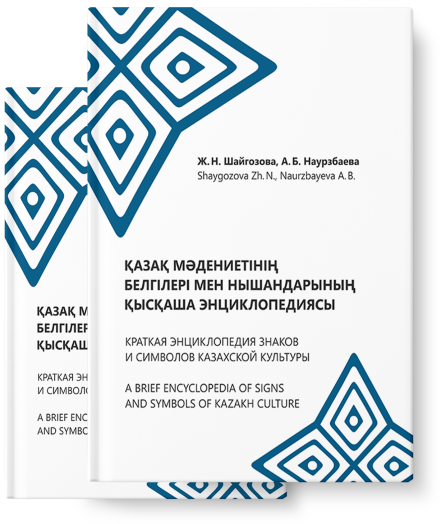
A short encyclopedia of
Signs and symbols of
Kazakh culture

The skulls of animals, namely horses and dogs, are active participants in some ritual acts and an object of worship among many nomadic peoples. The Mongols, for example, place the head of a favourite horse, a stallion that brings good offspring, or a fast horse on the rim as a sign of honour. At the same time, the holes at the eyes and ears of the skull are stuffed with dry grass, cookies, sweets, argal (dry dropping) or stones, and the skull is turned in the direction of the birthplaces [17, p.61]. Among the Kazakhs, the figure of the horse skull is found in the following cases: It was placed on a high place (the roof of a barn, the top of a rock, a tree branch) so that people and cattle could not step on it. The skull was also placed on the lintel of a mazar, put on a pole and placed as a guard over the fields. The skulls of famous racehorses and riding horses of the batyrs were sewn in felt, wrapped in chi (mat) and placed (“attyñ basyn kebindeu”) on the tops of high mountains, free-standing heights [20]. The skull of a horse was also used in the practise of the baqsy, Kazakh shamans. The skull was used to treat patients with mental confusion and other diseases. The ethnographic literature contains information about the treatment of sick people with the help of the skull and ritual dolls, where the skull is depicted as a horse and the doll as a girl. According to the Kazakhs, this duo facilitated the settlement of “flying” demons and djinns in the skull, i.e. the transmission of diseases into the skull. Such a ritual attribute is kept in the Russian Museum of Ethnology (REM). The use of a dog skull with dolls was also found among the Kazakhs in the healing practise of Baksy. A dry dog skull was painted in different colours by baqsy, and then cloth dolls (in odd numbers) were collected in each yurt. Diseases were also “transferred” to the yurt by special manipulations.
Ethnographic material about the Balkars and Karachais proves the belief in the magical properties of the horse’s skull. In times of drought, one had to throw a horse skull hung on a rope into a river, whereupon a torrential rain supposedly soon began to fall, flowing continuously until the skull was pulled out [6, p.42]. This rite can be described as a kind of imitative magic. The horse’s skull is projected as a mediator between worlds, a guardian (herd or traveller) that manifests itself in magical rituals and healing practises.

